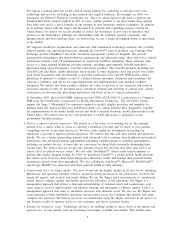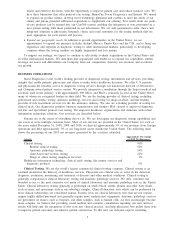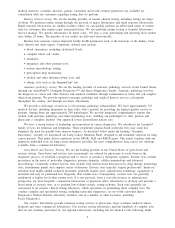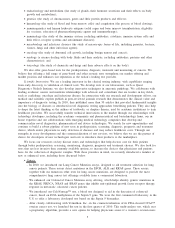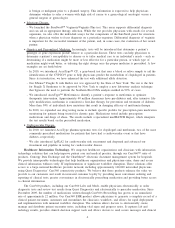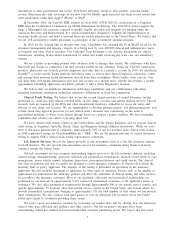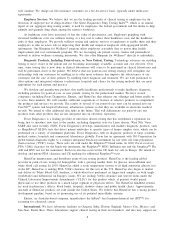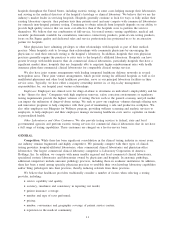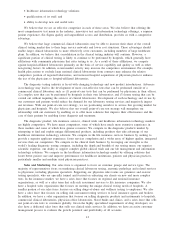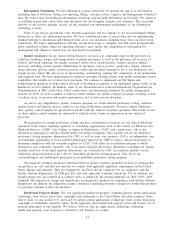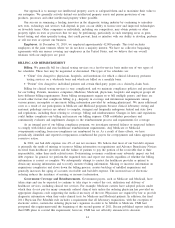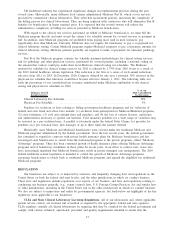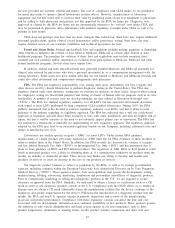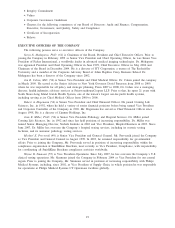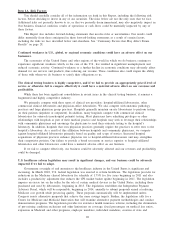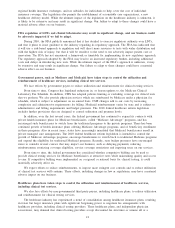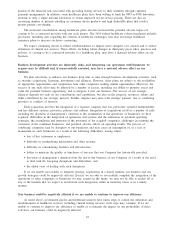Quest Diagnostics 2010 Annual Report Download - page 15
Download and view the complete annual report
Please find page 15 of the 2010 Quest Diagnostics annual report below. You can navigate through the pages in the report by either clicking on the pages listed below, or by using the keyword search tool below to find specific information within the annual report.•healthcare information technology solutions;
•qualifications of its staff; and
•ability to develop new and useful tests.
We believe that we are an effective competitor in each of these areas. We also believe that offering the
most comprehensive test menu in the industry, innovative test and information technology offerings, a superior
patient experience, Six Sigma quality and unparalleled access and distribution, provides us with a competitive
advantage.
We believe that large commercial clinical laboratories may be able to increase their share of the overall
clinical testing market due to their large service networks and lower cost structures. These advantages should
enable larger clinical laboratories to more effectively serve customers, including members of large healthcare
plans. In addition, we believe that consolidation in the clinical testing industry will continue. However, a
significant portion of clinical testing is likely to continue to be performed by hospitals, which generally have
affiliations with community physicians that refer testing to us. As a result of these affiliations, we compete
against hospital-affiliated laboratories primarily on the basis of service capability and quality as well as other
non-pricing factors. In addition, recent market activity may increase the competitive environment. For example,
health plan actions to exclude large national clinical laboratories from contracts may enhance the relative
competitive position of regional laboratories, and increased hospital acquisitions of physician practices enhance
the ties of the physicians to hospital-affiliated laboratories.
The diagnostic testing industry is faced with changing technology and new product introductions. Advances
in technology may lead to the development of more cost-effective tests that can be performed outside of a
commercial clinical laboratory such as (1) point-of-care tests that can be performed by physicians in their offices;
(2) complex tests that can be performed by hospitals in their own laboratories; and (3) home testing that can be
carried out without requiring the services of clinical laboratories. Development of such technology and its use by
our customers and patients would reduce the demand for our laboratory testing services and negatively impact
our revenues. With our point-of-care test strategy, we are positioning ourselves to service this growing market for
physicians and hospitals. We also believe that our overall point-of-care test strategy will strengthen our
relationship with our customers by enabling us to offer more solutions that improve their effectiveness and the
care of their patients by enabling faster diagnosis and treatment.
The diagnostic product, life insurance services, clinical trials and healthcare information technology markets
are highly competitive. We have many competitors, some of which have much more extensive experience in
these markets and some of which have greater resources. We compete in the diagnostic products market by
attempting to find and exploit unique differentiated products, including products that take advantage of our
healthcare information technology solutions. We compete in the life insurance services business by seeking to
provide a superior applicant experience, faster services completion and a wider array of highest quality, integrated
services than our competitors. We compete in the clinical trials business by leveraging our strengths as the
world’s leading diagnostic testing company, including the depth and breadth of our testing menu, our superior
scientific expertise, our ability to support complex global clinical trials and our lab management and information
technology solutions. We compete in the healthcare information technology market by offering solutions that
foster better patient care and improve performance for healthcare institutions, patients and physician practices,
particularly smaller and medium sized physician practices.
Sales and Marketing. Our sales force is organized to focus on customer groups and service types. The
majority of representatives focus on marketing clinical laboratory testing, anatomic pathology and related services
to physicians, including physician specialists. Supporting our physician sales teams are genomics and esoteric
testing specialists, who are specially trained and focused on educating our clients on new and more complex
tests. In the insurance market, we have a sales force that focuses on regional and national insurance
organizations, as well as a sales team that sells risk assessment services to life insurance companies. We also
have a hospital sales organization that focuses on meeting the unique clinical testing needs of hospitals. A
smaller portion of our sales force focuses on selling drugs-of-abuse and wellness testing to employers. We also
have a sales force that focuses on selling risk assessment testing services to local insurance agents and brokers.
In addition, we have a sales organization that focuses on selling diagnostic products and instruments to hospitals,
commercial clinical laboratories, physician office laboratories, blood banks and clinics, and a sales force that sells
our point-of-care tests to customers globally. Given the highly specialized requirements of drug developers, we
also have a dedicated sales force that sells our clinical trials services. In addition, we have an active customer
management process to evaluate the growth potential and profitability of all accounts.
12


